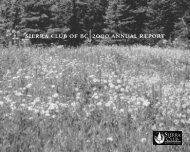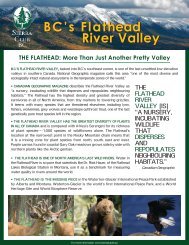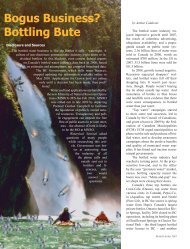Read our 2009 letter to the government. - Sierra Club BC
Read our 2009 letter to the government. - Sierra Club BC
Read our 2009 letter to the government. - Sierra Club BC
You also want an ePaper? Increase the reach of your titles
YUMPU automatically turns print PDFs into web optimized ePapers that Google loves.
Audra Gordon, Manager, Commercial Services<br />
Strategic Acquisitions and Technology Procurement<br />
Pacific Carbon Trust<br />
2 nd floor, 563 Superior Street,<br />
Vic<strong>to</strong>ria <strong>BC</strong>, V8W 9W6<br />
May 13, <strong>2009</strong><br />
Dear Ms. Gordon<br />
Re: Request for Information <strong>to</strong> assist <strong>the</strong> Pacific Carbon Trust (PCT) in <strong>the</strong> development<br />
of future forest GHG offset procurement<br />
Our organizations wish <strong>to</strong> provide comments and concerns related <strong>to</strong> <strong>the</strong> Request for Information<br />
#PCT-2371 - Forest Greenhouse Gas Offsets. We, <strong>the</strong> undersigned, recognize <strong>the</strong> leadership <strong>the</strong><br />
provincial <strong>government</strong> has shown by taking action on many climate-related issues. While direct<br />
reductions in GHG emissions remain <strong>the</strong> <strong>to</strong>p priority in meeting <strong>the</strong> provincial <strong>government</strong>‟s<br />
commitment <strong>to</strong> a carbon neutral public sec<strong>to</strong>r and meeting provincial GHG targets, we acknowledge<br />
that some emissions will remain <strong>to</strong> be offset. In this context, we support <strong>the</strong> PCT‟s mandate <strong>to</strong> provide<br />
quality <strong>BC</strong>-based offsets that are of high environmental integrity.<br />
In <strong>our</strong> submission, high quality forest-based offsets would be those that provide both real greenhouse<br />
gas (GHG) reduction benefits and biodiversity co-benefits. High quality forest-based offsets should<br />
provide incentives for forest conservation initiatives as a first priority, both <strong>to</strong> reduce greenhouse gas<br />
emissions and <strong>to</strong> give species and ecosystems <strong>the</strong> best chance in <strong>the</strong> face of climate change.<br />
We believe that <strong>the</strong> proposed silvicultural programs as described in <strong>the</strong> Request for<br />
Information (RFI) will compromise <strong>the</strong> ability of <strong>the</strong> PCT <strong>to</strong> provide high quality forestbased<br />
offsets due <strong>to</strong>:<br />
1. Negative ecological impacts in intensively managed forests<br />
2. Tenuous GHG benefits<br />
3. Lack of clarity as <strong>to</strong> how intensively managed forest offset projects can be<br />
financially viable while also being of ‘high quality’<br />
Specifically, <strong>the</strong> PCT focus on promoting a silviculture regime of fertilizing and using superior seed<br />
s<strong>to</strong>ck <strong>to</strong> improve volumes and growth rates, without extending rotations, implies that <strong>the</strong> PCT would<br />
grant offset credits <strong>to</strong> intensively managed forests that will eventually be logged.<br />
Such projects will certainly have negative ecological impacts. Managing an area intensively for <strong>the</strong> sole<br />
purpose of increasing volume will provide little benefit in terms of biodiversity, and does not guarantee<br />
that ecosystem functioning and complexity will be res<strong>to</strong>red <strong>to</strong> its natural state. The impact of chemical<br />
input <strong>to</strong> <strong>the</strong> environment from fertilizer application is ecologically questionable. Moreover, as
fertilizers have a considerable carbon footprint un<strong>to</strong> <strong>the</strong>mselves, this carbon input would need <strong>to</strong> be<br />
accounted for in <strong>the</strong> verification process.<br />
Modified forests and plantations are not as effective at s<strong>to</strong>ring carbon or providing ecosystem services,<br />
and support less biological diversity. 1 As <strong>the</strong> Pacific Institute for Climate Solutions recently noted:<br />
“While vigorous young stands have high NEP, <strong>the</strong>y never achieve <strong>the</strong> C s<strong>to</strong>cks that were contained in<br />
original primary and old-growth forest (e.g. Janzen 2006, Smithwick et al. 2002). This is particularly<br />
important where natural disturbances are infrequent and rarely stand destroying, such as coastal <strong>BC</strong>.” 2<br />
While not explicit, <strong>the</strong> RFI implies that <strong>the</strong> proposed projects are not intended solely for <strong>the</strong> purpose of<br />
meeting climate mitigation goals, but also <strong>to</strong> “harness <strong>the</strong> economic potential of carbon offsets‟” and<br />
“generate revenue”. We understand this <strong>to</strong> mean <strong>the</strong> stands could be logged, and are unclear as <strong>to</strong> how<br />
this is expected <strong>to</strong> result in net greenhouse gas removal from <strong>the</strong> atmosphere. Put ano<strong>the</strong>r way, while<br />
we understand that forest-based offsets would need <strong>to</strong> meet <strong>the</strong> Emission Offsets Regulation with<br />
respect <strong>to</strong> measures such as permanency and additionality, it is not at all clear how <strong>the</strong> intensive<br />
forestry approaches proposed in <strong>the</strong> RFI could do so. In addition, under <strong>the</strong> current model of industrial<br />
forest management and operations, it does not appear feasible that intensively managed forests could<br />
be logged in a manner that is both economically viable for a licensee, while also meeting requirements<br />
for high quality offsets, even taking in<strong>to</strong> account potential revenue from carbon offsets.<br />
Afforestation of marginal land or not-sufficiently-res<strong>to</strong>cked forest lands that have been without forest<br />
cover since 1989 may have a role <strong>to</strong> play in res<strong>to</strong>ration-focused forest carbon projects, but it is not clear<br />
from <strong>the</strong> RFI that <strong>the</strong>se would not eventually be logged as well. Fur<strong>the</strong>rmore, with respect <strong>to</strong><br />
afforestation projects, due <strong>to</strong> <strong>the</strong> time lag between when stands are planted and when <strong>the</strong>y begin <strong>to</strong><br />
remove carbon, revenue for projects will have <strong>to</strong> be received in installments over time, as PCT is only<br />
permitted <strong>to</strong> purchase ex-post credits. The time frame would surely be longer than <strong>the</strong> term of any<br />
current forestry tenure, and as such, <strong>the</strong> financial viability (or time value of money) of such a project is<br />
questionable.<br />
Conclusion<br />
Ambitious, immediate efforts <strong>to</strong> reduce <strong>our</strong> reliance on fossil fuels and resulting<br />
greenhouse gas emissions should be <strong>the</strong> highest priority for meaningful action now on<br />
climate change, both in achieving a ‘carbon neutral’ public sec<strong>to</strong>r and in meeting short<br />
term GHG reduction targets.<br />
Where emissions remain that are difficult or impossible <strong>to</strong> reduce, high quality offsets<br />
have a role <strong>to</strong> play.<br />
High quality forest carbon offsets must both<br />
a) provide real and immediate GHG emission reductions (result in an absolute net<br />
reduction of greenhouse gases after accounting for all greenhouse gas s<strong>our</strong>ces,<br />
sinks and reservoirs; measurable; verifiable; additional; permanent); and,<br />
b) have demonstrable benefits for biodiversity and resilience. 3<br />
1 Secretariat of <strong>the</strong> Convention on Biological Diversity, Draft Findings of Ad Hoc Technical Expert Group (AHTEG) on<br />
Biodiversity and Climate Change (UN Environment Programme, 2008) at 6-7.<br />
2 T. Andrew Black and Rachhpal S. Jassal, Carbon Sequestration in British Columbia’s Forests<br />
and Management Options (Pacific Institute for Climate Solutions, November 2008) at 7-8.<br />
3 And at a minimum have no net negative impacts on biodiversity and ecosystem function.
Conservation of intact ecosystems, old-growth and low-disturbance forests, and o<strong>the</strong>r<br />
carbon-s<strong>to</strong>ring ecosystems such as grasslands and wetlands, should be prioritized for<br />
immediate gains in carbon s<strong>to</strong>rage/avoided emissions and biodiversity co-benefits.<br />
Offsets, forestry-based or o<strong>the</strong>rwise, may be useful interim strategies. However, only robust, short term<br />
emissions reductions programs will provide <strong>the</strong> magnitude of greenhouse gas emission reductions<br />
required <strong>to</strong> avoid potentially catastrophic impacts of climate change that may result from crossing<br />
critical temperature increase thresholds.<br />
We enc<strong>our</strong>age you <strong>to</strong> centre a forest-based offset program on reduced emissions from avoided forest<br />
conversion (measures that prevent <strong>the</strong> conversion of forests <strong>to</strong> non-forest uses) and avoided<br />
degradation (measures that protect primary forests from logging). While „avoided conversion‟, part of<br />
<strong>the</strong> proposed California Climate Action Registry Forest Project Pro<strong>to</strong>col, is critical for <strong>the</strong> immediate<br />
and ongoing carbon s<strong>to</strong>rage contribution, given <strong>the</strong> realities of <strong>BC</strong>‟s forest sec<strong>to</strong>r <strong>the</strong> highest impact<br />
strategy for reducing emissions from a forestry perspective is „avoided degradation‟ of <strong>the</strong> forest carbon<br />
s<strong>to</strong>res in <strong>our</strong> primary forests.<br />
Fur<strong>the</strong>rmore, enhanced nature protection is an imperative <strong>to</strong> boost species‟ resilience, and support<br />
ecosystem integrity and functioning in <strong>the</strong> face of climate change. We recommend prioritizing <strong>the</strong><br />
identification and mapping of forested ecosystems of highest conservation and climate mitigation<br />
values. This would be a beneficial decision-support system that could identify priority areas in which <strong>to</strong><br />
implement forest conservation offset projects with dual carbon/biodiversity benefits.<br />
Robust forest offset projects, such as we have described, coupled with prioritizing reduced emissions<br />
from fossil fuel manufacture/use and o<strong>the</strong>r greenhouse gas-emitting activities, would better position<br />
British Columbia <strong>to</strong> continue <strong>to</strong> be seen as a global leader in climate change mitigation and adaptation.<br />
We believe that forest-based carbon offset projects could be high quality and enjoy broad-based support<br />
and credibility. To support this, we propose a pro<strong>to</strong>col development process with ENGO representation<br />
that would address <strong>the</strong> issues and priorities set out in this <strong>letter</strong>. In doing so, we note <strong>the</strong> need <strong>to</strong><br />
address <strong>the</strong> full range of carbon-related phenomena that occur in <strong>the</strong> categories of carbon removal,<br />
s<strong>to</strong>rage, and emissions that occur, e.g., emissions associated with forestry operations, inputs from<br />
chemical fertilizers, etc.<br />
Finally, development of offset pro<strong>to</strong>cols will need <strong>to</strong> be embedded in a more comprehensive dialogue<br />
involving o<strong>the</strong>r <strong>government</strong> agencies (Ministry of Forests and Range, Ministry of Environment, Climate<br />
Action Secretariat), ENGOs and o<strong>the</strong>r sec<strong>to</strong>rs <strong>to</strong>:<br />
identify optimal land use choices for <strong>BC</strong> <strong>to</strong> both reduce GHG emissions and support<br />
ecosystem/species adaptation in <strong>the</strong> face of climate change; and,<br />
recommend legal/policy and market mechanisms <strong>to</strong> incentivize <strong>the</strong>se choices.<br />
Thank you for considering <strong>our</strong> comments, concerns, and recommendations. See contact information<br />
below.
Contact Information<br />
Jessica Clogg, Senior Counsel<br />
West Coast Environmental Law<br />
Jessica_Clogg@wcel.org<br />
604-601-2501<br />
Candace Batycki, Direc<strong>to</strong>r of Forest Program<br />
ForestEthics<br />
candace@forestethics.org<br />
250-352-6609<br />
Stephanie Goodwin, Senior Forest Campaigner<br />
Greenpeace<br />
stephanie.goodwin@y<strong>to</strong>.greenpeace.org<br />
604-253-7701 x15<br />
Jens Wieting, Coastal Forest Campaigner<br />
<strong>Sierra</strong> <strong>Club</strong> <strong>BC</strong><br />
jens@sierraclub.bc.ca<br />
250-386-5255 x256<br />
Matt Horne, Direc<strong>to</strong>r - B.C. Energy Solutions<br />
The Pembina Institute<br />
matth@pembina.org<br />
604-874-8558 ext 223<br />
Neil Hughes, Forestry Program Manager<br />
Ecotrust Canada<br />
neil@ecotrust.ca<br />
250-898-7341<br />
John Bergenske, Executive Direc<strong>to</strong>r<br />
Wildsight<br />
john@wildsight.ca<br />
250-422-3566<br />
Tom Hackney, V-P for Policy<br />
<strong>BC</strong> Sustainable Energy Association<br />
thackney@shaw.ca<br />
250-381-4463<br />
Helen Goodland, Executive Direc<strong>to</strong>r<br />
Light House Sustainable Building Centre<br />
hgoodland@telus.net<br />
604-682-5960<br />
Dave Neads, Interior Program Manager<br />
<strong>BC</strong> Spaces for Nature<br />
precipice@xplornet.com<br />
250-742-3222
Sheila Harring<strong>to</strong>n, Executive Direc<strong>to</strong>r<br />
Land Trust Alliance of British Columbia<br />
sheila@landtrustalliance.bc.ca<br />
250-538-0112<br />
Chloe O'Loughlin, Executive Direc<strong>to</strong>r<br />
Canadian Parks and Wilderness Society - <strong>BC</strong> Chapter<br />
chloe@cpawsbc.org<br />
604-685-7445 ext 23









